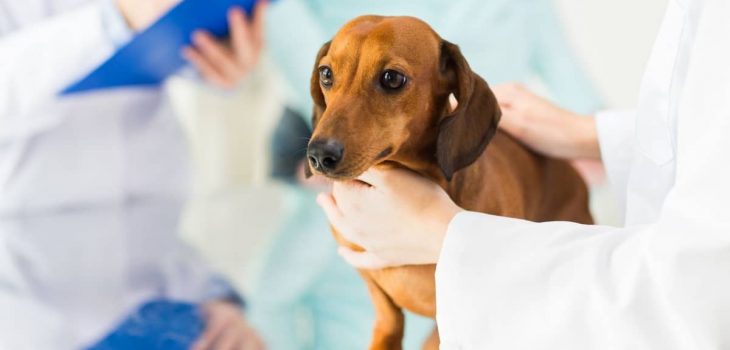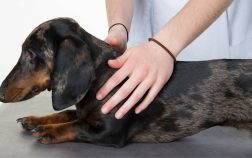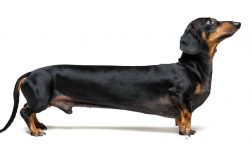Doxies are a relatively healthy breed. At least that is apart from their predisposition to back issues. So, what are the key dachshund back problems symptoms you should watch out for? Is your Doxie experiencing some symptoms right now that you’re just not noticing? How vital is it to spot your dog’s growing issues as soon as possible? We’ll go over all that, what you need to do about it, and how to prevent back problems altogether below.
What Are The Main Dachshund Back Problems Symptoms May Indicate?
Doxies unfortunately often suffer from Intervertebral Disc Disease (IVDD) – a problem that can appear almost anywhere on your dog’s spine. The good thing about IVDD is that it’s both preventable and treatable. The bad thing is that it’s quite common and very unpleasant.
Additionally, if IVDD is not caught early – read, if you ignore the symptoms for too long – it will require a surgical intervention and may leave your Dachshund a little or more debilitated or even permanently handicapped.
This all makes it all the more crucial that you keep an eye out for the main dachshund back problems symptoms.
7 Main Dachshund Back Problems Symptoms To Watch Out For
The earliest signs can vary a lot and can be difficult to spot. However, the main dachshund back injury symptoms are fairly easy to recognize:
1. An Audible Expression Of Pain
Doxies are usually vocal about the problems in their life, especially when they are well-socialized and when they feel at home. So, if your dachs has started audibly expressing pain when walking, chances are that the dog has some back problems. This is especially noticeable when the dog is going up or downstairs, ramps, or other elevations. So, keep an eye out in those moments, in particular.
Unfortunately, not all dachshunds will share their back pain so readily. This makes the following symptoms even more important to pay attention to.
2. A Change In The Dog’s Normal Stance
Dachshunds are normally a proud and energetic breed. So, the typical dachshund stance is that of a straight back and an upright head and neck. However, in the case of dachshund back problems, that signature stance will likely change. So, if you see that your dachshund is standing with a curved back and/or with a lowered head, this is likely an indication of IVDD.

Learn more about: Dog Slipped Disc Recovery Without Surgery – Is It Possible And How?
3. Bladder Control Issues
If your dachshund has started peeing indoors or in the wrong areas, this can indicate bladder problems. Slowly leaking when standing still is also possible. What do bladder control issues have to do with IVDD, however?
It turns out that one of the main symptoms of dachshund back problems is bladder control. Unfortunately, a lot of people just think that their dog is misbehaving or that it’s getting old. The latter may be true too but it’s also often connected with back problems.
4. Dietary Changes
Doxies love to eat and will rarely hesitate to clean out their food bowl. However, if you notice that your dog has started eating less than normal this can be another one of the key dachshund back problems signs. Drinking less water can also fall in this category. These are often due to a loss of appetite because of the pain and discomfort.
Alternatively, your Doxie may be having problems bending down to its bowls. The aforementioned issues with bladder control can also lead to a lack of thirst and hunger. Of course, dietary changes can be a symptom of other health problems too. Either way, contacting your vet immediately is always a good idea.
5. Change Inhabits
This is a less surefire symptom but it’s still a very important one. Even if your dog isn’t wincing in pain, avoiding eating, or weeing in the wrong places, some minor habit changes can still indicate IVDD. Some examples include:
- Reduced desire to go outside
- No interest in indoor playtime
- Avoiding going up and down your furniture, steps, or other elevated areas
6. Withdraw Upon Contact
Dogs love to be petted. And slow pets on the dog’s back are always enjoyable for both you and your pooch. However, if your dachshund has developed back problems you can start noticing a definite withdraw upon contact. This doesn’t mean that the dog doesn’t like your contact anymore – it most likely means that you’re triggering or increasing the back pain your dog is trying to deal with.
7. Aggression
If your dachshund has started showing you teeth, with or without an apparent reason, don’t be mad. Your dog likely isn’t misbehaving or “being bad”, it’s just grumpy because of the constant pain it’s been living with. We too are grumpy when we’re in pain. So, just put your dachs safely and easily in its crate and visit the vet as soon as possible.
How To Make Sure Your Dog Never Has To Deal With Such Dachshund Back Problems Symptoms?
Ideally, you will never have to deal with IVDD at all. And that is possible, especially with the right care. The first step comes even before that, of course, and it’s picking a healthy pup. This is why we always recommend avoiding pet stores and puppy mills – dogs there are bred indiscriminately and with no regard for their offspring’s health.
So, if possible, get a healthy pup from a breeder who’s offering a trustworthy health certificate with it. When adopting from a shelter or a rescue, asking for a vet check-up is also recommended.
Once you’ve got your pup home, however, it’s all a matter of how well you take care of it. Here are the main things to always do if you want a healthy and happy dachshund:
- Good food – dachshunds need a calcium-rich and a generally nutrient-rich diet
- Regular but measured exercise – proper exercise helps keep your dog’s weight in check and build up its muscles. However, avoid overexerting your dog or you might accidentally cause back problems
- Limit the overly high jumps your dog has to make – this includes up and down furniture, stairs, the step of a car, and so on. If you can, a good idea is to install mini ramps wherever possible to aid your dachshund’s movement. The less stress there is in the dog’s back, the less risk there is that it will ever experience back problems.




